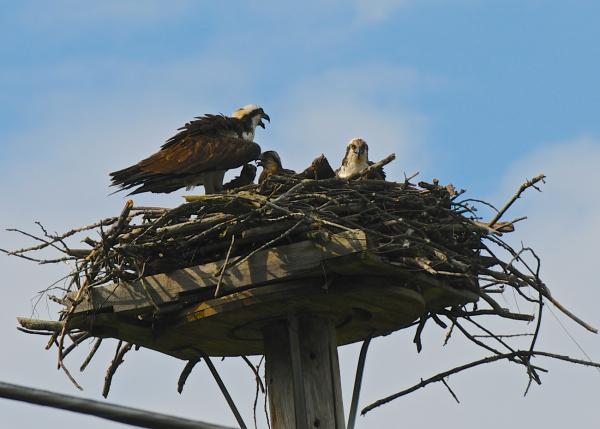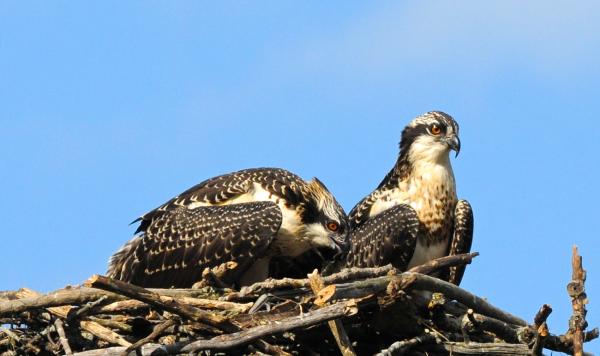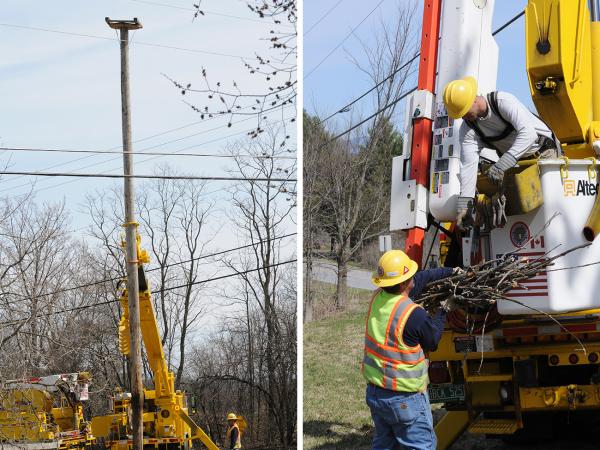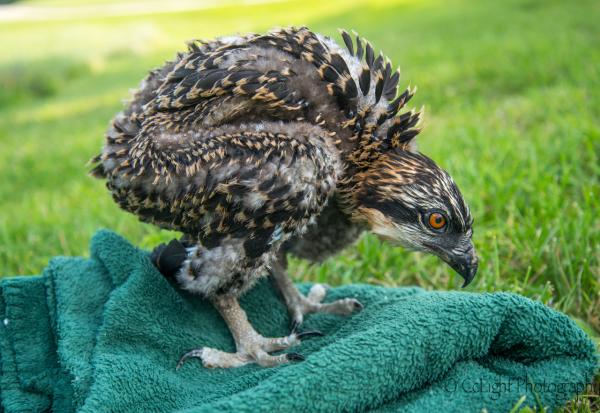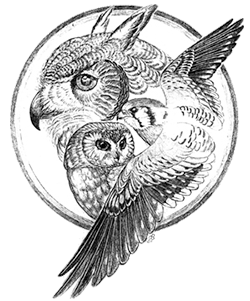Osprey Report - July 2017
You may have seen them swooping in over the Farm: large, hawkish looking birds with brown and white plumage, a brown mask, and curved, black beaks. They dive straight from the sky, plummet into the lake, and emerge from the waters with a fish clutched in their talons. If so, you’ve probably spotted one of the Farm’s four resident adult ospreys! Craig Newman of Outreach for Earth Stewardship tells us about the species and the individuals that call the Farm home:
Two Returning Pairs
There are two pairs of ospreys that migrate to the Farm once the weather warms. The first pair has been nesting in the field north of the Welcome Center for four years. The second pair has been nesting by the Dairy for two.
When ospreys return north in the spring, the males will arrive first, and the females shortly thereafter. The ospreys arrive at the Farm in early April, probably from the sunny shores of Florida, the Gulf of Mexico, or the northern shore of South America. The Welcome Center pair arrives to their northern nest a little sooner than those at the Dairy. Ospreys will typically return to where they hatched to build their own nests, but we’re not sure if that’s the case with these birds. They’ll head south around Labor Day.
The Nests
Possibly even more impressive than their diving skills? An osprey’s nest. Typically about four feet in diameter, ospreys build their gigantic nests on uncovered platforms, poles, and dead trees out in open fields nearby water. Breeding pairs return to the same nest annually, and they add more sticks and sod to their abode, creating taller and heavier structures year by year. The nests can get so large that they can conduct electricity and catch fire if the birds have staked their claim on a utility pole. This is why human intervention is critical to protect the birds in these cases. Once a pair has migrated south for the winter, nests can be transplanted to a safe structure nearby, often built just for this purpose. The birds don’t seem to mind the slight change in location.
This relocation process happened twice for the birds nesting near the Welcome Center. First, in April of 2013, Green Mountain Power moved the original nest from a power pole at the intersection of Harbor and Bay Roads to a safer pole erected just adjacent to the original. Afterwards, a state biologist surveyed the relocated nest and decided it needed to be moved again for the safety of the birds. The nest was transferred a second time in March of 2014 onto a pole built further from the road in the field north of the Welcome Center and Farm Store.
The site of the nest at the Dairy is being considered, too. The pair built their nest on a power pole supporting high voltage power lines. A non-utility pole has been installed nearby, and the Farm and Outreach for Earth Stewardship have plans to relocate the nest with the help of Green Mountain Power once the ospreys have migrated south.
The Chicks
Since the first pair nested on the Farm, nine chicks have fledged from the property. When the chicks have grown to the same size as their parents, they are ready to fledge, meaning they’re able to fly and leave the nest. How can you tell them apart from adults at this life stage? The adults have bright yellow eyes, and the youngsters have dark orange.
When new juveniles fly south for the winter, they’ll stay in the warmer climate for a full year to grow and mature. The chicks born on the Farm this season won’t return until the spring of 2019. Osprey juveniles migrate independently of their parents or other adult ospreys — they instinctively know the routes and where to nest.
“The osprey nest located at the dairy at Shelburne Farms was witness to an attack by two competing ospreys on Wednesday evening. [Dairy Manager] Sam Dixon, who saw the whole incident unfold, reported that two of the three chicks in the nest were taken out and one was killed. Hearing this news we investigated and were able to see one chick remaining in the nest but no sign of the parents or third chick. As we approached the base of the pole supporting the nest, a cry could be heard that was clearly not coming from above. Luckily, a second surviving chick was discovered on the ground nearby. A quick examination found no apparent injuries; a miracle in itself given it was snatched up by osprey talons and dropped to the ground.
If these chicks were to have any chance of survival it was obvious that the parents needed to return quickly. Once we verified the parents did indeed return, one of our volunteers, retired Green Mountain Power employee Terry Cecchini, placed a call to see if they would be willing to give this little one a lift back to his nest. Our friends at Green Mountain Power have a great record of helping out in these situations, and they responded quickly to help rehome the osprey chick. Garth and Eric, under the close supervision of Mom Osprey, carefully placed the chick along side its sibling. Hopefully this Osprey pair will be able to rear their two chicks in peace. Thanks to all involved in giving them a second chance.”
Happily — overall — ospreys are a wildlife success story! Formerly endangered in Vermont due to habitat loss, pollutants, and pesticides, they were removed from that list in 2005, thanks to federal, state, and private efforts to enhance nesting opportunities. Last year, Vermont Fish and Wildlife estimated that 200 osprey are fledged each year. We’ll keep the osprey updates coming, and we second OFES’s words of gratitude to everyone who has helped to rebuild the osprey population on the Farm and throughout the Northeast!
Outreach for Earth Stewardship (OFES) offers unique educational programs that stimulate the mind and heart with the help of live raptors who serve as wild ambassadors. Founded in 1989, OFES’s mission is to strengthen respect and understanding for wildlife through education. The organization formed a partnership with historic Shelburne Farms in 1997, and now is headquartered on the Farm. OFES relies solely on a dedicated core of volunteers and financial support of the community for its day to day operations. Follow OFES on Facebook, Instagram, and Twitter to learn about Vermont birds and tips for keeping them and their environment safe.
